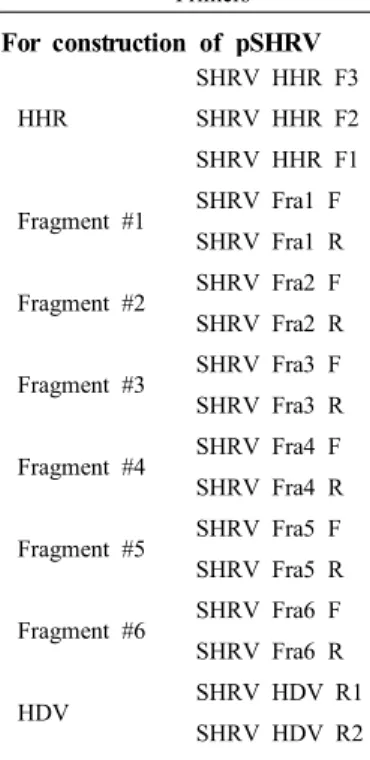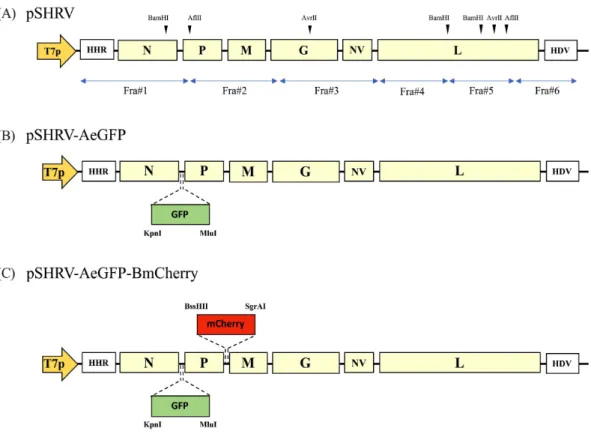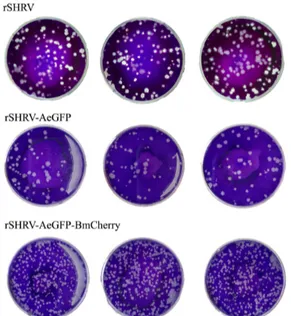J. Fish Pathol., 33(2) : 163~169 http://dx.doi.org/10.7847/jfp.2020.33.2.163
Introduction
Snakehead rhabdovirus (SHRV) is an enveloped, single negative-stranded RNA virus belonging to the genus Novirhabdovirus in the family Rhabdoviridae (Kasornchandra et al., 1992; Amarasinghe et al., 2019). The viral genome encodes six proteins in the order of nucleoprotein (N), polymerase-associated phosphoprotein (P), matrix protein (M), glycoprotein (G), non-virion protein (NV), and RNA-dependent RNA polymerase (L). The presence of the NV gene in the genome is a characteristics of the genus Novir-habdovirus (Kurath et al., 1985). SHRV was first iso-lated from snakehead fish (Ophicephalus striatus)
during an epizootic ulcerative syndrome (EUS) out-break in Thailand (Wattanavijarn et al., 1986), but the role of SHRV in EUS epizootics had not been exactly demonstrated (Kasornchandra et al., 1992). It is now well-known that infection by a fungal species, Aphanomyces invadans, is the primary cause of EUS (Iberahim et al., 2018; Herbert et al., 2019), and SHRV is not the principal cause of EUS.
The production of recombinant viruses using re-verse genetic technology has made it possible to ana-lyze the function of each viral gene, through which our understanding on the mechanism of virus repli-cation and pathogenesis could be enhanced. In addi-tion, reverse genetically rescued recombinant viruses can be utilized as live-attenuated vaccines and foreign genes delivery vehicles. Various types of recombinant novirhabdoviruses such as infectious hematopoietic
Generation of heterologous proteins-expressing recombinant
snakehead rhabdoviruses (rSHRVs) using reverse genetics
Jun Soung Kwak, Sujeong Ryu and Ki Hong Kim
†Department of Aquatic Life Medicine, Pukyong National University, Busan 48513, South Korea
Snakehead rhabdovirus (SHRV) is different from other fish novirhabdoviruses such as viral hemorrhagic septicemia virus (VHSV), infectious hematopoietic necrosis virus (IHNV), and hirame rhabdovirus (HIRRV) in that it replicates at high temperatures. Therefore, the delivery of foreign proteins to fish living at high water temperature would be possible by using recombinant SHRVs. In the present study, to evaluate the possible use of SHRV as a vehicle for foreign proteins delivery, we generated a recombinant SHRV that contains an enhanced-GFP (eGFP) gene between nucleoprotein (N) and phosphoprotein (P) genes (rSHRV-A-eGFP), and another recombinant SHRV expressing two heterologous genes by inserting an eGFP gene between N and P genes, and mCherry gene between P and M genes (rSHRV-AeGFP-BmCherry). Epithelioma papulosum cyprini (EPC) cells infected with the recombinant SHRVs showed strong fluorescence(s), suggesting the possible availability of recombinant SHRVs for the development of combined vaccines by expressing multiple foreign antigens.
Key words: Recombinant snakehead rhabdovirus (rSHRVs), Reverse genetics, Delivery of heterologous
genes.
†
Corresponding author: Ki Hong Kim Tel: +82-51-629-5943; Fax: +82-51-629-5938 E-mail: khkim@pknu.ac.kr
necrosis virus (IHNV) and viral hemorrhagic septice-mia virus (VHSV) have been generated using reverse genetics, and the availability of attenuated recombi-nant viruses as live vaccines has also been inves-tigated (Romero et al., 2011; Rouxel et al., 2016; Kim and Kim, 2019). In SHRV, however, only NV gene-mutated or NV gene-deleted recombinant SHRV had been rescued for the analysis of NV gene function in viral replication and virulence (Johnson et al., 2000; Alonso et al., 2004). Later, Gabor et al. (2013) mentioned that they had produced a green fluorescent protein (GFP)-expressing recombinant SHRV by re-placing SHRV NV ORF with GFP ORF.
In contrast to other fish novirhabdoviruses such as VHSV, IHNV, and hirame rhabdovirus (HIRRV) that can replicate only at low temperature, SHRV repli-cates at high temperatures, which would be advanta-geous in the delivery of foreign proteins to fish that are living in high water temperatures. In the present study, to evaluate the possible use of SHRV as a ve-hicle for foreign proteins delivery, we generated a re-combinant SHRV that contained an enhanced-GFP (eGFP) gene between N and P genes (rSHRV-A-eGFP), and another recombinant SHRV expressing two heter-ologous genes by inserting an eGFP gene between N and P genes, and mCherry gene between P and M genes (rSHRV-AeGFP-BmCherry).
Materials and methods
Cells and virusEpithelioma papulosum cyprini (EPC) (ATCC: CRL-2872) cells were grown in Leibovitz medium (L-15, Sigma) supplemented with penicillin-strepto-mycin (Welgene) and 10% fetal bovine serum (FBS, Welgene).
SHRV (ATCC-VR1386) and recombinant SHRVs were propagated in the monolayer of EPC cells at 28℃ in the presence of 2% FBS. When the cytopathic effect (CPE) was broadly observed, the supernatant was collected following centrifugation and filtered
with a 0.45 μm syringe filter (Advantec), then, kept at -80°C until use.
Generation of recombinant wild-type SHRV (rSHRV-wild)
To construct a viral vector which harboring the an-tigenomic cDNA of SHRV, total RNA was extracted from wild type SHRV-infected EPC cells. The anti-genomic cDNA of SHRV was divided into six frag-ments (#1 - #6) and amplified by PCR using primers in Table 1. To exactly trim the ends of SHRV ge-nome, hammerhead ribozyme was fused to 5' end of fragment #1, and hepatitis delta virus ribozyme was fused to 3' end of the fragment #6. All the amplified PCR fragments were cloned into T-easy vector (Pro-mega) and sequenced. The six fragments were assem-bled by Overlap cloner (ELPIS, Korea) according to the manufacturer’s instruction, and the constructed vector was designated as pSHRV. To construct helper vectors, SHRV’s N and P genes were amplified by PCR using pSHRV as a template and cloned into T- easy vector, then, ligated to pFC vector (SystemBio) using restriction enzymes (AgeI, NotI), and designat-ed as pFC-SHRV-N and pFC-SHRV-P. SHRV’s L gene was divided into two fragments due to its long size, and named as L1 and L2. Each fragment was amplified by PCR using pSHRV as a template and cloned into T-easy vector. The L1 fragment was li-gated into the pFC vector using AgeI and SpeI re-striction enzymes, then, the L2 fragment was inserted just behind the L1 fragment using restriction enzymes (SpeI, NotI). The constructed vector was named as pFC-SHRV-L. All primers for construction helper vectors were represented in Table 1.
EPC cells expressing T7 RNA polymerase were seeded on 35 mm dish about 80% confluence, and were transfected with the mixture of pSHRV (2000 ng), pFC-SHRV-N (500 ng), pFC-SHRV-P (300 ng), and pFC-SHRV-L (200 ng) using Fugene HD trans-fection reagent (Promega). When extensive cytopathic effect (CPE) was observed, cells were lysed by a
Table 1. Primers used in this study Primers Sequence (5’-3’) For construction of pSHRV HHR SHRV HHR F3 CGCGGGAATTCGATTACCGGTTGATACCTGATGAGTCCGTGAGGACG SHRV HHR F2 CTGATGAGTCCGTGAGGACGAAACGAGTAAGCTCGTC SHRV HHR F1 GAGTAAGCTCGTCGTATCAAAAAAGATGATGATACTTGGAAG
Fragment #1 SHRV Fra1 F GTATCAAAAAAGATGATGATACTTGGAAGAAGAGAT
SHRV Fra1 R TGATGGCTCATCTTAAGTTGTCTAATGTACTGT
Fragment #2 SHRV Fra2 F ACAACTTAAGATGAGCCATCAGGAAG
SHRV Fra2 R GGATTTTCCCATTCTTCCGAGTACTCGACAATGC
Fragment #3 SHRV Fra3 F GAGTACTCGGAAGAATGGGAAAATCCCATATACACAACCCC
SHRV Fra3 R AAAATTCCATCTCCTGTCCGTTTCAG
Fragment #4 SHRV Fra4 F GGACAGGAGATGGAATTTTTTGATCTGGACCTCGAGAT
SHRV Fra4 R TAGGTGATGAGGACAATGGAGGTCT
Fragment #5 SHRV Fra5 F CCATTGTCCTCATCACCTAACCC
SHRV Fra5 R CCGCTACAACCTCCTCCTCC
Fragment #6 SHRV Fra6 F AGGAGGTTGTAGCGGGGAG
SHRV Fra6 R GCCGGCCGTATAGAAAAAGATGATATATTTTTTTCTAGGACAAATCCAG
HDV SHRV HDV R1 TGCCCAGCCGGCGCCAGCGAGGAGGCTGGGACCATGCCGGCCGTATAG
SHRV HDV R2 GCGGCCGCGTCCCATTCGCCATGCCGAAGCATGTTGCCCAGCCGGCGCCAG
For construction of helper vectors
pFC-SHRV-N AgeI SHRV N F ACCGGTATGGCTTTTCAGAAAGAGTTCTTTGG NotI SHRV N R GCGGCCGCTTAGGCATACTTGCTGTAGTCCTGA pFC-SHRV-P AgeI SHRV P F ACCGGTATGGCAGAATCGATCGAGATG NotI SHRV P R GCGGCCGCTCACTTTGTGAGTTCAGCCTTCG pFC-SHRV-L L1 AgeI SHRV L F CCGACTGAAACGGACAGGAACCGGTGATGGAATTT L_SpeI_R GTGCTCGGGTCAACTAGTCGATAGCTCATG L2 L_SpeI_F CATGAGCTATCGACTAGTTGACCCGAGCAC NotI SHRV L R GCGGCCGCTCAGCGATCCCCCAACGGGA
For construction of pSHRV-AeGFP
SHRV 1227 F GAGATCATCAAGAGTGCTGTCCGT
SHRV NP R CATGGTACCCCTCCTGAAGGTTCTCTTGTGTCT
eGFP OC F TTCAGGAGGGGTACCATGGTGAGCAAGGGC
eGFP OC R AGTTCTGTTACGCGTTTACTTGTACAGCTCGT
SHRV NP F TAAACGCGTAACAGAACTTCCCCCCTAACGAGT
For construction of pSHRV-AeGFP-BmCherry
SHRV PM R CTCCTCGCCCTTGCTCACCATGCGCGCTTTGATCTCTTTTG
mCherry_OC_F CAAAAGAGATCAAAGCGCGCATGGTGAGCAAGGGCGAGGAG
mCherry_OC_R GTTGGGTGTGGGTGGTCCGGACTACTTGTACAGCTCGTCCATGCCGCC
SHRV PM F GGCGGCATGGACGAGCTGTACAAGtagTCCGGACCACCCACACCCAAC
AB_SHRV_Cassette_R CCTAGGTCAGTCCTGATCCACTGTTC
freeze-thaw, and centrifuged at 8,000 rpm for 10 min. The collected supernatant was filtered with a 0.45 μ syringe filter and passaged on EPC cells to augment the recombinant virus.
Generation of recombinant SHRVs expressing single or dual reporter proteins (rSHRV-AeGFP and rSHRV-AeGFP-BmCherry)
To use recombinant SHRVs as a foreign gene ex-pression vehicle, vectors for the generation of single or dual reporter protein(s)-expressing SHRVs were constructed. For the rescue of single reporter pro-tein-expressing rSHRV, eGFP gene was inserted be-tween N and P genes using Overlap cloner, and named as pSHRV-AeGFP. For dual reporter pro-teins-expressing rSHRV, mCherry gene was inserted between the P and M genes of pSHRV-AeGFP using Overlap cloner, and designated as pSHRV-AeGFP- BmCherry (primers are in Table 1).
EPC cells expressing T7 RNA polymerase were co- transfected with pSHRV-AeGFP or pSHRV-AeGFPB- mCherry and helper vectors (pFC-SHRV-N, pFC- SHRV-P, and pFC-SHRV-L) using FugeneHD. Sup-ernatants containing recombinant SHRVs were stored at -80℃ before being used. To analyze the titer of generated recombinant viruses, plaque assay was performed. EPC cells (2 × 106 cells/35 mm dish) were infected for 2 h with each serially diluted viral stock (10-3 to 10-5) at 28℃. After incubation, the medium was removed and dishes were overlaid with plaque medium (0.7% agarose in L-15 containing 2% FBS and antibiotics), and incubated until viral plaques were distinguishable under the light. The fixing and staining were performed with 10% formalin and 5% crystal violet, respectively. After rinsing with distilled water, the plaque-forming units (PFU) were counted.
Expression of reporter proteins
To verify the expression of the reporter protein from cells infected with the recombinant viruses, cells infected with rSHRV-AeGFP or rSHRV-AeGFP-Bm
Cherry were observed using a fluorescence micro-scope. EPC cells (2 × 106 cells/35 mm dish) were in-fected for 2 h with 10-4 diluted viral stock at 28℃. After incubation, the medium was removed and dishes were overlaid with plaque medium, then, the expression of fluorescence was observed using a flor-escent microscope.
Results
Generation of recombinant SHRVs
Recombinant SHRVs expressing single reporter protein (rSHRV-AeGFP) and dual reporter proteins (rSHRV-AeGFP-BmCherry) were successfully gen-erated by reverse genetics method (Fig. 1). Cells in-fected with the recombinant viruses showed CPE, and the production of infectious viral particle was verified by the formation of plaques (Fig. 2).
Fluorescence of cells infected with rSHRV- AeGFP and rSHRV-AeGFP-BmCherry
The expression of fluorescent protein in EPC cells infected with rSHRV-AeGFP or rSHRV-AeGFP-Bm Cheery was ascertained by a fluorescence microscope. Cells infected with rSHRV-A-eGFP showed a clear green fluorescence (Fig. 3). Cells infected with rSHRV- AeGFP-BmCherry showed both green and red fluo-rescence (Fig. 3).
Discussion
Researches on the development of recombinant VHSVs for the platform of delivering foreign antigens or cytokines have been reported (Kim and Kim, 2019). However, as VHSV can replicate only below 20℃, the foreign proteins inserted into the genome cannot be properly expressed beyond 20℃, which would act as a hurdle to be used as a delivery vehicle in fish culturing above 20℃. On the other hand, as SHRV can replicate at high temperature range (optimal at temperatures between 28-31℃) (Johnson
et al., 2000), it can be possible to deliver foreign pro-teins to fish living at high water temperature by re-combinant SHRVs. In the present study, we success-fully generated foreign protein(s)-expressing recombi-nant SHRVs, and verified the expression of the for-eign protein(s) in cells infected with the recombinant SHRVs, suggesting the high potential of recombinant SHRVs for the development of combined vaccines by expressing multiple foreign antigens. Previously, Kim et al. (2016) reported that rVHSV containing eGFP and red fluorescent protein (RFP) ORFs in the genome showed retarded growth and severely weak-ened virulence in olive flounder (Paralichthys oliva-ceus). Similarly, in the growth of recombinant SHRVs, rSHRV-AeGFP showed significantly lower viral titer than rSHRV-wild, and the plaque size of rSHRV-A-
eGFP-BmCherry was significantly smaller than rSHRV- AeGFP. These results suggest that a lengthened ge-nome size by the insertion of foreign genes into nov-irhabdoviral genome can lead to viral attenuation. Phelan et al. (2005) reported that more than 40% mor-talities were occurred by the infection of adult zebra-fish (Danio rerio) with SHRV. However, in our pre-liminary experiments, we could not get any mortal-ities by the infection with SHRV in zebrafish and even in fingerlings of snakehead fish (Channa argus). As the present recombinant SHRVs also did not in-duce any mortality in zebrafish, we could not demon-strate in vivo attenuation of rSHRV-AeGFP and rSHRV-A-eGFP-BmCherry. Further studies are re-quired to know what factors are involved in the in vivo virulence of SHRV.
Fig. 1. Schematics representation of plasmids for the generation of a recombinant wild type SHRV (pSHRV), a rSHRV containing eGFP gene between N and P genes (pSHRV-AeGFP), a rSHRV harboring eGFP gene and mCherry gene between N/P and P/M junctions, respectively (pSHRV-AeGFP-BmCherry). T7p, T7 RNA polymerase promoter; HHR, hammerhead ribozyme; HDV, hepatitis delta virus ribozyme; T7Φ, T7 RNA polymerase terminator.
Acknowledgements
This work was supported by a Research Grant of Pukyong National University, Republic of Korea (2019 year).
References
Alonso, M., Kim, C.H., Johnson, M.C., Pressley, M. and Leong, J.A.: The NV gene of snakehead rhabdovirus (SHRV) is not required for pathogenesis, and a het-erologous glycoprotein can be incorporated into the SHRV envelope. J. Virol., 78: 5875–5882, 2004. Amarasinghe, G.K., Ayllón, M.A., Bào, Y. et al.:
Taxon-omy of the order Mononegavirales: update 2019. Arch. Virol., 164: 1967-1980, 2019.
Gabor, K.A., Sullivan, C. and Kim, C.H.: Mononegavi-ruses of Veterinary Importance. Volume I: Pathobi-ology and Molecular Diagnosis. Ed., Munir M., Chapter 22. Snakehead Rhabdovirus. p. 337-353. CAB International, 2013.
Herbert, B., Jones, J.B., Mohan, C.V. and Perera, R.P.: Impacts of epizootic ulcerative syndrome on sub-sistence fisheries and wildlife. Rev. Sci. Tech., 38: 459-475, 2019.
Iberahim, N.A., Trusch, F. and West, P.V.: Aphanomyces invadans, the causal agent of epizootic ulcerative syndrome, is a global threat to wild and farmed fish. Fungal. Biol. Rev., 32: 118-130, 2018.
Johnson, M.C., Simon, B.E., Kim, C.H. and Leong, J.A.: Production of recombinant snakehead rhabdovirus: the NV protein is not required for viral replication. J. Virol., 74: 2343-2350, 2000.
Kasornchandra, J., Engelking, H.M., Lannan, C.N., Ro-hovec, J.S. and Fryer, J.L.: Characteristics of three rhabdoviruses from snakehead fish Ophicephalus striatus. Dis. Aquat. Org., 13: 89-94, 1992. Kim, M.S. and Kim, K.H.: Genetically engineered viral
hemorrhagic septicemia virus (VHSV) vaccines. Fish Shellfish Immunol., 95: 11-15, 2019.
Kim, M.S., Lee, S.J., Kim, D.S. and Kim, K.H.: Generation of recombinant viral hemorrhagic septi-cemia virus (rVHSV) expressing two foreign pro-teins and effect of lengthened viral genome on viral growth and in vivo virulence. Mol. Biotechnol., 58: 280-286, 2016.
Kurath, G., Ahern, K.G., Pearson, G.D. and Leong, J.C.: Molecular cloning of the six mRNA species of in-Fig. 2. Plaque formation in EPC cells infected with
rSHRV (10-4 diluted stock), rSHRV-AeGFP (10-4 diluted
stock), and rSHRV-AeGFP-BmCherry (10-3 diluted stock). Cells were cultured under 0.7% agarose containing pla-que medium, fixed and stained at 3 days post-infection.
Fig. 3. Green fluorescence and green/red fluorescence in EPC cells infected with rSHRV-AeGFP (Left) and rSHRV-AeGFP-BmCherry (Right), respectively. Cells in the center region (arrow) were detached by CPE.
fectious hematopoietic necrosis virus, a fish rhabdo-virus, and gene order determination by R-loop map-ping. J. Virol., 53: 469-476, 1985.
Phelan, P.E., Pressley, M.E., Witten, P.E., Mellon, M.T., Blake, S., Kim, C.H.: Characterization of snakehead rhabdovirus infection in zebrafish (Danio rerio). J. Virol., 79: 1842-1852, 2005.
Romero, A., Dios, S., Bremont, M., Figueras, A. and Novoa, B.: Interaction of the attenuated recombinant rIHNV-Gvhsv GFP virus with macrophages from rainbow trout (Oncorhynchus mykiss). Vet. Immunol. Immunopathol., 140: 119-129, 2011.
Rouxel, R.N., Tafalla, C., Mérour, E., Leal, E., Biacchesi, S. and Brémont, M.: Attenuated infectious hema-topoietic necrosis virus with rearranged gene order as potential vaccine. J. Virol., 90: 10857-10866, 2016.
Wattanavijarn, W., Tangtronpiros, J. and Wattanodorn, K.: Viruses of ulcerative diseased fish in Thailand, Burma, and Laos, p. 121. In First International Con-ference on the Impact of Viral Diseases on the De-velopment of Asian Countries, Bangkok, Thailand, 1986.
Manuscript Received : Aug 24, 2020 Revised : Sep 3, 2020 Accepted : Dec 1, 2020


